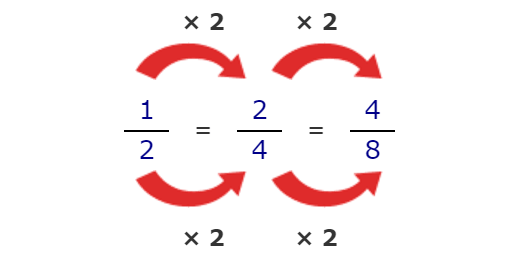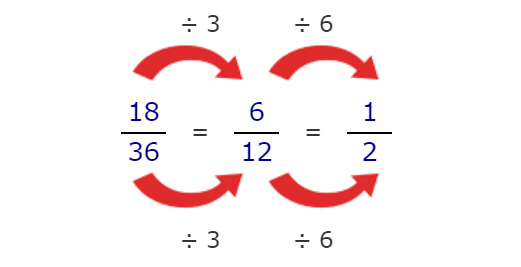EQUIVALENT FRACTIONS
Subscribe to our ▶️ YouTube channel 🔴 for the latest videos, updates, and tips.
The fractions which are equivalent have the same value, even though they may look different. These fractions are really the same.
For example,
¾ = ⁶⁄₈ = ⁹⁄₁₆
Why are they the same ?
Because, when we multiply or divide both the numerator and denominator by the same number, the fraction keeps it's value.
Understanding Equivalent Fractions
Let us divide a rectangle into two equal parts and shade one of the parts.

In the above rectangle, the shaded part is ½.
That is, in total of 2 parts, one part is shaded.
Let us divide the same rectangle into four equal parts and shade 2 parts.

In the above rectangle, the shaded part is ²⁄₄.
That is, in total of 4 parts, two parts are shaded.
Let us divide the same rectangle into six equal parts and shade 3 parts.

In the above rectangle, the shaded part is ³⁄₆.
That is, in total of 6 parts, three parts are shaded.
In all the above figures, the shaded portion are equal but they can be represented by different fractions.
½ = ²⁄₄ = ³⁄₆
When two or more fractions represent the same part of a whole, the fractions are called equivalent.
Rule to Find Equivalent Fractions
Change both numerator and denominator using multiplication or division by the same number.
Example :
Using multiplication :

½, ²⁄₄ and ⁴⁄₈ are equivalent fractions.
Using division :

¹⁸⁄₃₆, ⁶⁄₁₂ and ½ are equivalent fractions.
Solved Problems
Problem 1 :
Write 4 fractions which are equivalent to ⅚.
Solution :
To find 4 fractions which are equivalent to ⅚, multiply both numerator and denominator of the fraction ⅚ by 2, 3, 4 and 5.
⅚ = ⁽⁵ˣ²⁾⁄₍₆ₓ₂₎ = ¹⁰⁄₁₂
⅚ = ⁽⁵ˣ³⁾⁄₍₆ₓ₃₎ = ¹⁵⁄₁₈
⅚ = ⁽⁵ˣ⁴⁾⁄₍₆ₓ₄₎ = ²⁰⁄₂₄
⅚ = ⁽⁵ˣ⁵⁾⁄₍₆ₓ₅₎ = ²⁵⁄₃₀
The four fractions which are equivalent to ⅚ are
¹⁰⁄₁₂, ¹⁵⁄₁₈, ²⁰⁄₂₄ and ²⁵⁄₃₀
Problem 2 :
Write 3 fractions which are equivalent to ³⁄₇.
Solution :
³⁄₇ = ⁽³ˣ²⁾⁄₍₇ₓ₂₎ = ⁶⁄₁₄
³⁄₇ = ⁽³ˣ³⁾⁄₍₇ₓ₃₎ = ⁹⁄₂₁
³⁄₇ = ⁽³ˣ⁴⁾⁄₍₇ₓ₄₎ = ¹²⁄₂₈
The four fractions which are equivalent to ³⁄₇ are
⁶⁄₁₄, ⁹⁄₂₁ and ¹²⁄₂₈
Problem 3 :
Write 4 fractions which are equivalent to 0.03.
Solution :
Write 0.03 as as a fraction.
0.03 = ³⁄₁₀₀
To find 4 fractions which are equivalent to ³⁄₁₀₀, multiply both numerator and denominator of the fraction ³⁄₁₀₀ by 2, 3, 4 and 5.
³⁄₁₀₀ = ⁽³ˣ²⁾⁄₍₁₀₀ₓ₂₎ = ⁶⁄₂₀₀
³⁄₁₀₀ = ⁽³ˣ³⁾⁄₍₁₀₀ₓ₃₎ = ⁹⁄₃₀₀
³⁄₁₀₀ = ⁽³ˣ⁴⁾⁄₍₁₀₀ₓ₄₎ = ¹²⁄₄₀₀
³⁄₁₀₀ = ⁽³ˣ⁵⁾⁄₍₁₀₀ₓ₅₎ = ¹⁵⁄₅₀₀
The four fractions which are equivalent to ³⁄₇ are
⁶⁄₂₀₀, ⁹⁄₃₀₀, ¹²⁄₄₀₀ and ¹⁵⁄₅₀₀
Problem 4 :
Pick out the fractions which are equivalent :
⅖, ¹²⁄₁₆, ⅓, ⁵⁄₁₅, ¹⁶⁄₄₀, ¾, ⁹⁄₁₂
Solution :
The fractions ⅖ and ¹⁶⁄₄₀ are equivalent.
Because,
⅖ = ⁽²ˣ⁸⁾⁄₍₅ₓ₈₎ = ¹⁶⁄₄₀
The fractions ¹²⁄₁₆, ¾ and ⁹⁄₁₂ are equivalent.
Because,
¹²⁄₁₆ = ⁽¹²÷⁴⁾⁄₍₁₆÷₄₎ = ¾
and
⁹⁄₁₂ = ⁽⁹÷³⁾⁄₍₁₂÷₃₎ = ¾
The fractions ⅓ and ⁵⁄₁₅ are equivalent.
Because,
⅓ = ⁽¹ˣ⁵⁾⁄₍₃ₓ₅₎ = ⁵⁄₁₅
Problem 5 :
Find the missing numbers :
⁵⁄₉ = ³⁵⁄? = ?⁄₇₂
Solution :
The numerator of the first two fractions are 5 and 35. And 5 will become 35, when we multiply 5 by 7.
So, we have to multiply the denominator of the first fraction 9 by 7 in order to get the denominator of the second fraction.
9x7 = 63
Hence, the denominator of the second fraction is 63.
The denominator of the first and third fraction are 9 and 72. And 9 will become 72, when we multiply by 8.
So, we have to multiply the numerator of the first fraction 5 by 8 in order to get the numerator of the third fraction.
Hence, the numerator of the third fraction is 40.
⁵⁄₉ = ³⁵⁄₆₃ = ⁴⁰⁄₇₂
Problem 6 :
Find the missing numbers :
⅗ = ²¹⁄? = ?⁄₂₀
Solution :
The numerator of the first two fractions are 3 and 21. And 3 will become 21, when we multiply by 7.
So, we have to multiply the denominator of the first fraction 5 by 7 in order to get the denominator of the second fraction.
Hence, the denominator of the second fraction is 35.
The denominator of the first and third fraction are 5 and 20. And 5 will become 20, when we multiply by 4.
So, we have to multiply the numerator of the first fraction 3 by 4 in order to get the numerator of the third fraction.
Hence, the numerator of the third fraction is 12.
⅗ = ²¹⁄₃₅ = ¹²⁄₂₀
Problem 7 :
If the following two fractions are equivalent, find the value of x.
⁹⁄₈ and ˣ⁄₅₆
Solution :
Since ⁹⁄₈ and ˣ⁄₅₆ are equivalent fractions,
⁹⁄₈ = ˣ⁄₅₆
The denominator on the right side is 56. In the fraction ⁹⁄₈, the denominator is 8. To get an equivalent fraction with denominator 56, we have to multiply both numerator and denominator of the fraction ⁹⁄₈ by 7.
⁽⁹ˣ⁷⁾⁄₍₈ₓ₇₎ = ˣ⁄₃₆
⁶³⁄₅₆ = ˣ⁄₃₆
The above two fractions are equivalent with the same denominator. Then, the numerators must be equal.
Therefore,
x = 63
Problem 8 :
If the following two fractions are equivalent, find the value of y.
⁻⁶⁄₁₈ and ʸ⁄₃
Solution :
Since ⁻⁶⁄₁₈ and ʸ⁄₃ are equivalent fractions,
⁻⁶⁄₁₈ = ʸ⁄₃
The denominator on the left side is 3. In the fraction ⁻⁶⁄₁₈, the denominator is 18. To get an equivalent fraction with denominator 3, we have to divide both numerator and denominator of the fraction ⁻⁶⁄₁₈ by 6.
⁻⁽⁶÷⁶⁾⁄₍₁₈÷₆₎ = ʸ⁄₃
⁻¹⁄₃ = ʸ⁄₃
The above two fractions are equivalent with the same denominator. Then, the numerators must be equal.
Therefore,
y = -1
Subscribe to our ▶️ YouTube channel 🔴 for the latest videos, updates, and tips.
Kindly mail your feedback to v4formath@gmail.com
We always appreciate your feedback.
About Us | Contact Us | Privacy Policy
©All rights reserved. onlinemath4all.com

Recent Articles
-
US Common Core K-12 Curricum Algebra Solving Simple Equations
Jan 07, 26 01:53 PM
US Common Core K-12 Curricum Algebra Solving Simple Equations -
10 Hard SAT Math Questions (Part - 4)
Jan 05, 26 06:56 PM
10 Hard SAT Math Questions (Part - 4) -
10 Hard SAT Math Questions (Part - 3)
Jan 05, 26 06:34 PM
10 Hard SAT Math Questions (Part - 3)

